At the Reserve Bank of Australia press conference in June, Reserve Bank of Australia Governor Michelle Bullock said the board discussed raising interest rates. The meeting was held before the release of monthly CPI indicator data.
Tight labor market conditions are likely to ease concerns among RBA board members about rising borrowing costs and rising unemployment. Hawkish interest rates from the Reserve Bank of Australia could push AUD/USD towards $0.70.
Experts’ views on RBA interest rate path
Commenting on the labor market data, Russel Chester, head of investments and capital markets at VanEck, said:
“The data released today is not the Hail Mary the RBA was hoping for.[…]. With inflation at 4% and no signs of slowing, the RBA will at some point give in and raise interest rates. This is the only way to actually reduce inflation.
However, monthly consumer price index (CPI) data elicited mixed reactions.
David Ingles, chief markets editor for Bloomberg TV's Asia-Pacific region, also took a hawkish view, suggesting there was a 50-50 chance of the Reserve Bank of Australia raising interest rates in September.
In contrast, Westpac Chief Economist Luci Ellis holds a dovish view and expects a rate cut in November.
U.S. Economic Calendar: In Focus FOMC Members
Federal Open Market Committee (FOMC) voting members Raphael Bostic and John Williams will speak at the meeting later on Friday.
This week, New York Fed President John Williams dismissed plans to cut interest rates in July but supported a September cut. Unless Williams deviates from his previous comments, Bostic's views could have a bigger impact on AUD/USD. The president of the Atlanta Fed has not commented on monetary policy since Fed Chairman Jerome Powell's testimony and speech.
Recent inflation and labor market data have fueled expectations that the Federal Reserve may cut interest rates in September. Views on inflation, the economy and the timing of the Fed rate cut could change the dynamics.
According to the CME FedWatch tool, the probability of a rate cut by the Federal Reserve in September fell from 100% on Wednesday to 98.1% on Thursday. 98.1% said investors are very confident in interest rate cuts.
Short term forecast: Bullish
The near-term trend in AUD/USD depends on central bank comments. The Fed's dovish comments may support investors' bets on multiple rate cuts by the Fed in 2024. A more dovish interest rate path from the Fed could tilt the monetary policy divergence towards the Australian dollar and push AUD/USD towards $0.70.
Investors should remain vigilant as the Fed's spokesman will be in focus on Friday. Monitor real-time data, news updates and expert commentary to fine-tune your trading strategy.
Stay up to date with our latest views and analysis to manage risk in the FX market.
AUD/USD price trend
Daily chart
AUD/USD remains above the 50-day and 200-day moving averages, confirming the bullish price signal.
A return of AUD/USD to the $0.67500 level will support its move towards the $0.67967 resistance. Additionally, a break above the $0.67967 resistance may send bulls towards the $0.68500 mark.
Speeches from members of the Federal Open Market Committee (FOMC) need to be considered on Friday.
Conversely, a fall below the $0.67003 support in AUD/USD could allow bears to trade near the top trendline and the 50-day EMA. A break below the 50-day moving average would see the 200-day moving average.
With the 14-period daily RSI reading at 51.39, the Australian dollar is likely to break above the $0.67967 resistance and then enter the overbought zone.
